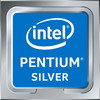Intel Pentium Silver N6000 vs Intel Core 2 Duo T6670 vs Intel Core 2 Duo T9500
Intel Pentium Silver N6000
► remove from comparison
The Intel Pentium Silver N6000 is a quad-core SoC of the Jasper Lake series that is primarily intended for inexpensive notebooks and was announced in early 2021. The four Tremont CPU cores clock between 1.1 and 3.3 GHz (single core Burst) and offer no HyperThreading (SMT). The N6000 uses 1.5 MB L2 and 4 MB L3 cache. The chip is manufactured on the first-gen 10 nm Intel process, the same process as Ice Lake.
Architecture
The processor architecture is called Tremont and a complete redesign compared to the old Golmont Plus cores in the predecessor. According to Intel, the single thread performance of a core could be improved by 30% on average (10 - 80% in all tests of SPECint and SPECfp).
Features
In addition to the four CPU cores, the SoC integrates a 32 EU Intel UHD Graphics GPU clocked from 350 - 850 MHz and a dual-channel DDR4 / quad-channel LPDDR4x memory controller (up to 16 GB and 2933 MHz). The chip now also partly integrates Wi-Fi 6 (Gig+), 8 PCIe 3.0 lanes, 14 USB 2.0/ 3.2 ports and two SATA 6.0 ports. The package got bigger and measures 35 x 24 mm (compared to 25 x 24 mm for the N5030 e.g.). The SoC is directly soldered to the mainboard (BGA) and can't be easily replaced.
Performance
The average N6000 in our database proves to be an OK entry-level processor, as of late 2022, its multi-thread benchmark scores nearly matching those of the AMD Ryzen 3 3200U. Yes, the chip is a whole lot slower than the latest Ryzen 3 and Core i3 processors, but it will at least let you run your day-to-day apps without annoying slowdowns.
The Asus Vivobook 13 Slate is among the fastest systems built around the N6000 that we know of, thanks to the long-term CPU power limit of 10 W. It can be more than 20% faster in CPU-bound workloads than the slowest system featuring the same chip in our database, as of August 2023.
Power consumption
Like nearly all other N-class Intel processors, the Pentium N6000 has a default TDP of 6 W (also known as the long-term power limit). This is low and thus good enough for passively cooled tablets, laptops, mini-PCs.
The SoC is built with Intel's 2nd generation 10 nm process (not 10 nm SuperFin or Intel 7) for low, as of mid 2023, energy efficiency.
Intel Core 2 Duo T6670
► remove from comparisonThe Intel Core 2 Duo T6670 is an entry level laptop processor based on the Penryn core. It offers only 2 MB level 2 cache and a mediocre clock rate of 2.2 GHz. Compared to the similar T6600, the T6670 offers Virtualization VT-x and a higher maximum temperature of 105°C.
Intel Core 2 Duo T9500
► remove from comparison
The Intel Core 2 Duo T9500 was a upper middle class dual core CPU for laptops at the time of introduction. It was intended to be used in the Santa Rosa platform due to the 800 MHz FSB. The T9550 is only slightly higher clocked but offers already a FSB1066.
Due to the relatively high clock speed and 6MB Level 2 cache, the T9500 offers enough performance for demanding games (in 2009) and applications.
The T9500 uses a Penryn (Montevina Update) core that features 2 integer units, 1 floating point unit, 1 load unit, and 1 store unit in a 14-stages long pipeline. Due to the Wide Dynamic Execution Technology, the core is able to simultaneously execute up to four instructions.
The integrated Enhanced Speedstep is able to downclock the core dynamically to save power (in idle mode).
| Model | Intel Pentium Silver N6000 | Intel Core 2 Duo T6670 | Intel Core 2 Duo T9500 | ||||||||||||||||||||||||||||||||
| Codename | Jasper Lake | Penryn | Penryn | ||||||||||||||||||||||||||||||||
| Series | Intel Jasper Lake | Intel Core 2 Duo | Intel Core 2 Duo | ||||||||||||||||||||||||||||||||
| Series: Core 2 Duo Penryn |
| ||||||||||||||||||||||||||||||||||
| Clock | 1100 - 3300 MHz | 2200 MHz | 2600 MHz | ||||||||||||||||||||||||||||||||
| L2 Cache | 1.5 MB | 2 MB | 6 MB | ||||||||||||||||||||||||||||||||
| L3 Cache | 4 MB | ||||||||||||||||||||||||||||||||||
| Cores / Threads | 4 / 4 | 2 / 2 | 2 / 2 | ||||||||||||||||||||||||||||||||
| TDP | 6 Watt | 35 Watt | 35 Watt | ||||||||||||||||||||||||||||||||
| Technology | 10 nm | 45 nm | 45 nm | ||||||||||||||||||||||||||||||||
| max. Temp. | 105 °C | 105 °C | 105 °C | ||||||||||||||||||||||||||||||||
| Socket | BGA1338 | PGA478 | BGA479, PGA478, PPGA478 | ||||||||||||||||||||||||||||||||
| Features | DDR4-2933/LPDDR4x-2933 RAM, PCIe 3 x 8, GNA, MMX, SSE, SSE2, SSE3, SSSE3, SSE4.1, SSE4.2, SMEP, SMAP, EIST, TM1, TM2, Turbo, SST, AES-NI, RDRAND, RDSEED, SHA | Virtualization Technolgoy (VT-x), Intel 64, Idle States, Enhanced Speedstep, Execute Disable Bit | |||||||||||||||||||||||||||||||||
| iGPU | Intel UHD Graphics (Jasper Lake 32 EU) (350 - 850 MHz) | ||||||||||||||||||||||||||||||||||
| Architecture | x86 | x86 | x86 | ||||||||||||||||||||||||||||||||
| Announced | |||||||||||||||||||||||||||||||||||
| Manufacturer | ark.intel.com | ark.intel.com | ark.intel.com | ||||||||||||||||||||||||||||||||
| FSB | 800 | 800 | |||||||||||||||||||||||||||||||||
| Transistors | 410 Million | 410 Million | |||||||||||||||||||||||||||||||||
| Die Size | 107 mm2 | 107 mm2 | |||||||||||||||||||||||||||||||||
| L1 Cache | 128 KB | ||||||||||||||||||||||||||||||||||
| Voltage | 1.0-1.25V V | ||||||||||||||||||||||||||||||||||
| $530 U.S. |
Benchmarks
Average Benchmarks Intel Pentium Silver N6000 → 100% n=5
Average Benchmarks Intel Core 2 Duo T6670 → 48% n=5
Average Benchmarks Intel Core 2 Duo T9500 → 72% n=5
* Smaller numbers mean a higher performance
1 This benchmark is not used for the average calculation












